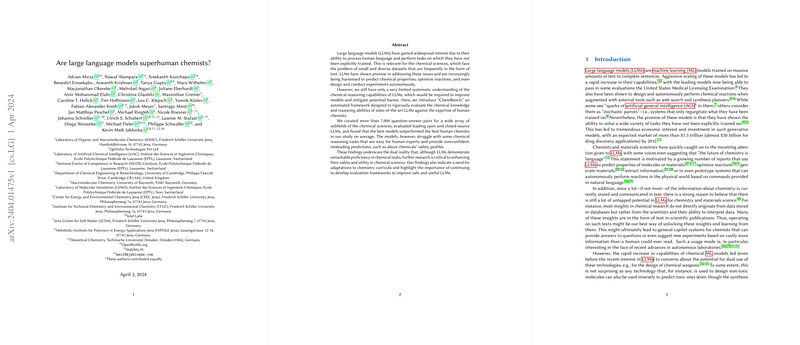Exploring the Chemical Reasoning Capabilities of LLMs
Introduction
ChemBench presents an innovative framework designed to assess the chemical knowledge and reasoning abilities of state-of-the-art LLMs in comparison with human chemists. This framework addresses the current gap in a systematic understanding of LLMs' capabilities within the chemical sciences domain, a gap that needs bridging to enhance models and mitigate potential harms. The comprehensive paper evaluates the performance of leading LLMs across over 7,000 question-answer pairs, covering a broad spectrum of the chemical sciences, and benchmarks these against the expertise of human chemists.
Benchmark Corpus
The ChemBench corpus is meticulously curated from diverse sources, ensuring a rigorous challenge across a breadth of topics within the chemical sciences. The dataset is notably diverse, featuring questions ranging from multiple-choice to open-ended formats, reflecting real-world applications more accurately than current benchmarks. Moreover, a "tiny" subset of the corpus facilitates routine evaluation practices, balancing broad coverage with pragmatic constraints of computational resources and time.
Model Evaluation
Comprehensive Evaluation
The evaluation of various models using ChemBench reveals intriguing insights. Of note, Claude 3, a leading LLM, demonstrates a performance that exceeds even the best human chemists in the paper on average. This indicates a remarkable proficiency in chemical tasks by current LLMs. However, the performance spectrum of LLMs varies widely across different subfields of chemistry, highlighting areas of strengths and weaknesses.
Tool-Augmented Systems
The paper also extends into the field of tool-augmented systems, showing their current limitations due to computational constraints. This underlines the necessity for advancements in tool integration to fully exploit the potential of LLMs in chemical reasoning tasks.
Performance Analysis
The detailed examination of performance across different topics uncovers a nuanced understanding of LLM capabilities. For specific topics like macromolecular chemistry and biochemistry, LLMs show impressive strengths. However, challenges remain in areas such as chemical safety and analytical chemistry, where LLMs struggle with tasks that require nuanced chemical reasoning or safety assessments.
Confidence Estimates
Assessing LLMs' ability to self-evaluate their confidence in their answers provides critical insights into their reliability. The analysis indicates that, for some models, confidence estimates do not reliably correlate with the correctness of the answers. This highlights a crucial area for future development, aiming for LLMs that can accurately gauge and communicate their confidence levels.
Conclusions and Future Directions
The groundbreaking analysis provided by ChemBench paves the way for a deeper understanding of the chemical reasoning capabilities of LLMs. While showcasing the significant achievements of LLMs in surpassing human performance on average in chemical tasks, the paper also reveals the pressing need for improvements in certain areas. The findings advocate for a shift in chemistry education towards developing critical reasoning skills, given the evolving landscape of chemical research with the advent of LLMs.
Looking forward, ChemBench sets the stage for continuous advancement and evaluation of LLMs in the chemical sciences. By offering a deep dive into the strengths and limitations of current models, this paper not only directs the focus towards crucial areas for improvement but also ignites discussion on the optimization of model-human interaction. The comprehensive benchmark framework established by ChemBench thus marks a significant step forward in realizing the full potential of LLMs in furthering chemical sciences.
